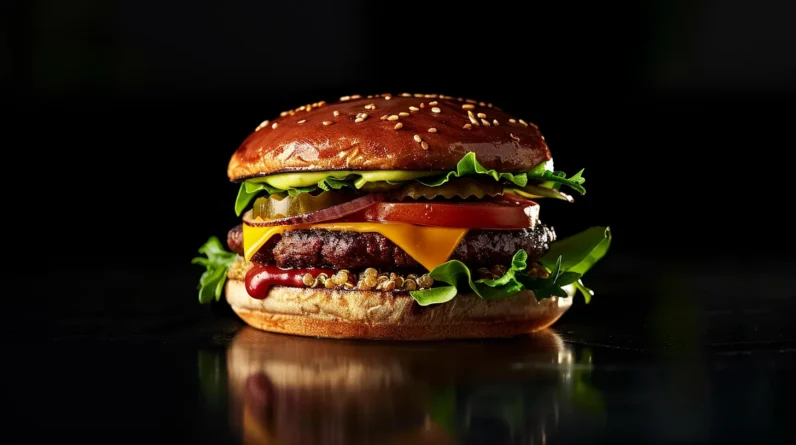
We’ve witnessed veggie burgers transform dramatically since their humble beginnings as basic grain-and-bean patties. The early versions were often dry and crumbly, lacking the satisfying taste and texture of meat burgers. But since the mid-2010s, companies like Beyond Meat and Impossible Foods have revolutionized plant-based options through scientific innovation. They’ve introduced game-changing ingredients like pea protein, coconut oil, and heme proteins to create juicy, meat-like experiences. Today’s veggie burgers feature in fast-food chains, grocery stores, and food trucks, proving that plant-based alternatives aren’t just for vegetarians. The story of this remarkable culinary evolution holds even more surprising developments.
From Bland to Bold
Over the past few decades, veggie burgers have evolved from simple grain-and-bean patties into sophisticated plant-based creations. We’ve witnessed their transformation from basic health food store staples of the 1970s to today’s innovative alternatives that rival traditional meat burgers in taste and texture.
In the early days, we made do with patties that were often dry, crumbly, and one-dimensional in flavor. But as food science advanced and consumer demand grew, we’ve seen the emergence of groundbreaking ingredients like pea protein, coconut oil, and beet juice that create juicy, meat-like experiences. Now, we’re crafting veggie burgers using sophisticated techniques like high-moisture extrusion and precision fermentation, producing patties that sizzle, “bleed,” and satisfy even dedicated carnivores with their bold, complex flavors.
The Rise of Plant-Based Innovation
Innovation in plant-based technology has revolutionized the veggie burger landscape since the mid-2010s. We’ve witnessed groundbreaking developments in protein extraction and meat replication techniques, particularly with companies like Beyond Meat and Impossible Foods leading the charge. These innovations have transformed plant proteins from simple soy and wheat bases into sophisticated meat analogues that effectively mimic the taste, texture, and cooking properties of traditional beef.
The emergence of heme proteins, specifically leghemoglobin from soy roots, has enabled us to recreate the “bleeding” effect in plant-based patties. We’re now seeing advanced ingredients like pea protein isolates, coconut oils, and potato starches working together to deliver the juiciness and char we expect from conventional burgers. This scientific approach has elevated veggie burgers from mere alternatives to genuine culinary contenders.
Game-Changing Ingredient Breakthroughs
Progress in ingredient science has opened up remarkable new possibilities for plant-based burgers since 2015. We’ve witnessed breakthrough innovations in protein extraction, particularly with pea protein isolates and soy leghemoglobin, which have revolutionized texture and taste profiles.
In 2016, we saw the emergence of heme proteins that replicate meat’s iron-rich flavor, while methylcellulose became essential for binding and juiciness. By 2018, food scientists mastered the art of coconut oil manipulation to mimic beef fat’s mouthfeel, and mung bean protein entered the scene to enhance texture.
The latest innovations include precision fermentation techniques producing animal-free proteins and the use of jackfruit’s fibrous structure. We’re now seeing mycelium technology and advanced extrusion processes creating meat-like fibers that weren’t possible just a few years ago.
Fast Food’s Veggie Revolution
Major fast food chains began embracing veggie burgers in 2019, marking a turning point in mainstream plant-based dining. When Burger King introduced the Impossible Whopper, we witnessed a domino effect across the industry. McDonald’s followed with the McPlant, while Carl’s Jr. partnered with Beyond Meat for their Beyond Famous Star.
We’re now seeing these plant-based options become permanent fixtures on fast food menus, rather than limited-time offerings. What’s remarkable is how these chains have maintained their signature flavors while adapting to plant-based proteins. They’re using familiar toppings, sauces, and preparation methods that mirror their traditional burgers. This standardization has helped normalize veggie burgers for mainstream consumers, making them more accessible than ever. The fast food industry’s embrace of plant-based options has fundamentally changed how we think about quick-service restaurants.
Beyond Traditional Restaurant Boundaries
The rise of veggie burgers hasn’t stopped at restaurant doors. We’ve witnessed their expansion into multiple channels, transforming how we access and enjoy plant-based alternatives. What began in restaurants has evolved into a thorough ecosystem of consumption options.
Today, we’re seeing veggie burgers appear in places we never imagined:
– Meal kit services delivering pre-portioned ingredients with detailed recipes
– Food trucks specializing in creative plant-based interpretations
– Grocery store meat departments featuring dedicated plant-based sections
– University cafeterias and corporate dining facilities offering daily options
This distribution revolution has democratized access to veggie burgers, making them available beyond traditional dining establishments. We’ve moved from limited availability at select restaurants to widespread accessibility, marking a significant shift in how these alternatives reach consumers’ plates.
Conclusion
We’ve watched veggie burgers evolve like caterpillars into butterflies, transforming from simple grain patties into culinary masterpieces that rival their meaty counterparts. From the humble beginnings of bland bean burgers in the 1960s to today’s bleeding plant-based innovations, we’re witnessing a food revolution that’s reshaping our plates. As these options continue sprouting up everywhere from drive-thrus to fine dining, we’re entering a new chapter in sustainable eating.







